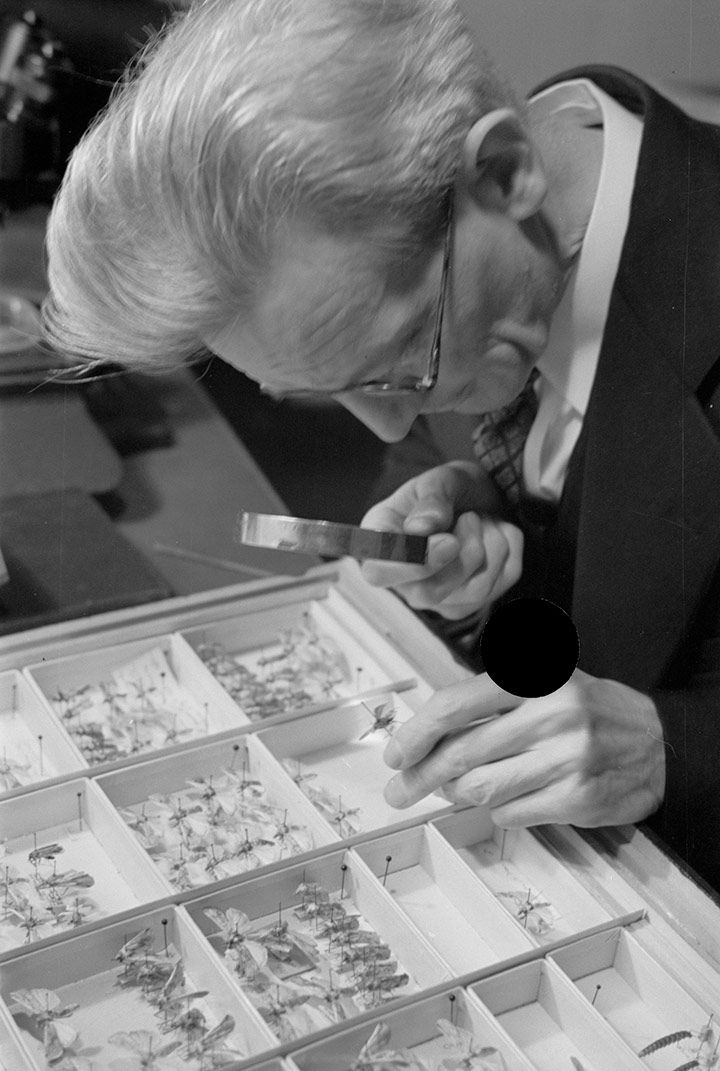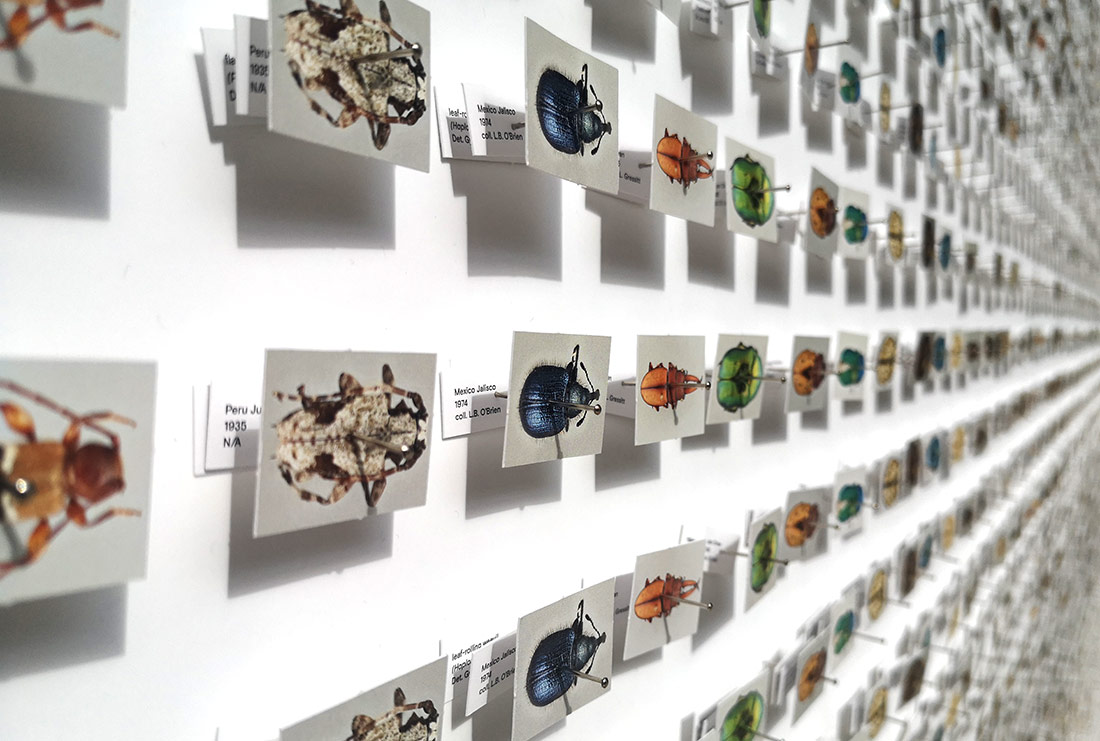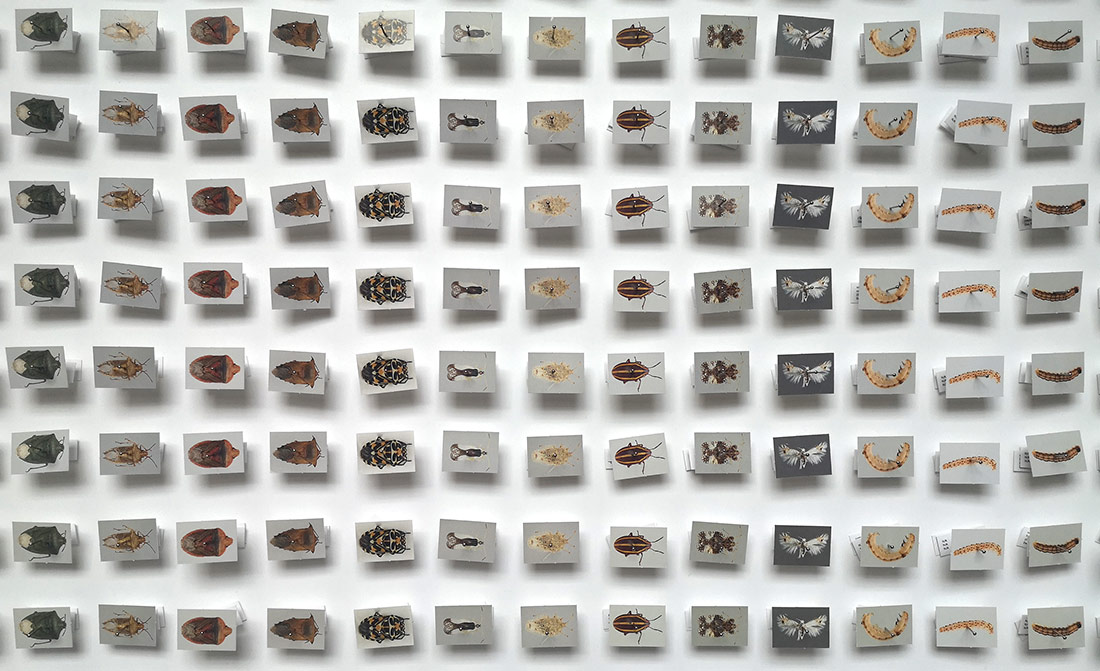
Insect identification, 1938 | Arthur Rothstein, Library of Congress | Public domain
In Inanimate Species, Joana Moll expresses extinction and pollution[1] quite literally in terms of analogy: the encroachment of microchips is compared to the extinction of insects. The comparison between these two visually similar[2] groups of beings is a measure of artificiality of pollution, as well as of inherent inconsistencies in methods of measurement. The attempt to taxonomize microchips following the rules of taxonomy for living organisms – an already artificial method applied to nature – suggests a possible way of forging an agreement on shared measures and values.
Talking about Pollution: Carbon, Colonialism and Appropriation
Cumulative fossil fuel emissions constitute a major cause of anthropogenic pollution: they increase the concentration of carbon dioxide in the atmosphere[3] and contribute to the global warming of the planet. To offset this measurable pollution, many have suggested ways to equate the levels of these emissions to some form of monetary investment. The Global Carbon Budget is one prominent way of mediating between emissions and investments, between scientific knowledge and policy making.[4] The suggested globality of the carbon budget paints the world united, and measures emissions as simple accumulation. But the global budget is not directly equitable to the global temperature increase. A direct translation between the two oversimplifies climate dynamics: temperature increases differently depending on how carbon emissions are distributed over time. Nevertheless, scientists today agree that budgeting might be the most robust and scientifically constrained measure of permissible emissions within a specific temperature increase limit.
The focus on permissible emissions frames pollution as a measurable and manageable phenomenon, presupposing unproblematic access and entitlement to land and resources, whose assimilative capacity can be measured. Max Liboiron demonstrated in Pollution is Colonialism[5] that the very understanding of pollution as ‘assimilable’ carries an extractive relationship to land, which is supposed to serve as a sink for discarded stuff. Pollution occurs when the sink is no longer able to clean itself. In other words, pollution is only problematic and is only really pollution when it saturates a certain threshold of measurement. This, for Liboiron, is one of many instances of a colonial relationship to land. Pollution, they argue, is not a symptom of capitalism but a violent enactment of colonial relations that claim access to Indigenous land. In short, pollution is colonialism.
Any act of polluting is at the same time an act of appropriation. Michel Serres wrote about this coincidence in his book about the ways in which pollution communicates power and hegemony.[6] The world is our host, and we appropriate it by filling the air with fossil fuel emissions, releasing toxicants into the water or saturating markets with products we do not need; we turn the world into objects that can be owned, into property. Instead of placing ourselves at the centre, Serres suggests reserving the centre for things, and considering ourselves within them, like parasites.[7] While it is important to remember that saying ‘we’ in context of pollution tends to obscure differences in responsibility and access to resources, Serres’ proposal could be read as a call to suspended judgement over entitlement. To be a parasite is to live off nutrients and energy from the host. Coincidentally, the term parasite is informed by the Ancient Greek notion of parasitos, denoting a person who eats at the table of another, who feeds beside the rich and earns their welcome by flattery.[8] Being a parasite and polluting is not the same, but they both manifest in appropriation and subversion of resources, eating the world next to one another.

Especies inanimadas, una instalación de Joana Moll
Metabolic Grounds: This Will Eat That
In Inanimate Species, Joana Moll systematically traces two seemingly unrelated trends: the increase in the number and proliferation of microchips, and the loss of volume and number of known insect species. Looking at the Intel® 4004, the first commercial general-purpose programmable processor on one hand, and the current insect extinction rates on the other, Moll’s artistic project problematises the tracking of biodiversity loss. The creation of the Intel microprocessor in 1971 could be alternatively dated as ‘year 1’ according to Unix time.[9] Coincidentally, its commercial release made it possible to store and process large volumes of data on a large scale. It also coincided with beginning of systematic documentation of biodiversity loss. While the loss in the number of species is hard to specify and is usually measured through comparison of volumes of insect mass, the proliferation of microchips can be measured precisely by transistor count, currently expressed in tens of sextillions (1036).
Joana Moll’s project seems to propose a metabolic relationship between microchips and insects, formed through pollution, parasitism and destruction of habitat. When microprocessors work, they consume energy. The manufacture of microprocessors leaves holes in the ground from which ores with rare-earth elements (REE) are extracted; the complex entanglements of fuels, chemicals, water and labour leave a significant environmental footprint. While certain kinds of insects, such as the dung beetle, metabolise the soil by working through the excrements of other animals so the earth can more easily absorb them, their comparison to the way microchips proliferate suggests that an inanimate species is about to eat up life. Importantly, the Inanimate Species hypothesis does not enter into controversial arguments about causal relationships. The comparison between the increase in anthropogenic mass and the reduction of insect biomass brings up the question of what can be considered as ‘life’.
Measuring Pollution: Topology and Taxonomy
The guiding principle for putting biodiversity loss and anthropogenic pollution on the same plane is visual: microprocessors look like bugs. The measurement of anthropogenic mass could be expressed in terms of equation of proportionalities, as a symbolic systematicity. Vera Bühlmann discusses such a comparative approach to symbolisation in her entry on ‘Equation’ for the Posthuman Glossary. Equation works beyond equating quantities as magnitude and multitude (for example, ‘how much’ or ‘how many’ lost species), towards a symbolic systematicity that establishes a comparative method. Similarly, non-causality in Inanimate Species’ treatment of microprocessors and insects implies an articulation of a proportional comparison of unrelated magnitudes. Joana Moll encodes and decodes the relations and their qualities in this equation.
The measurement of extinction could also be considered topologically: continuous transformations preserve certain properties under deformations, while propagating change across the topological space. In Contagious Architecture, Luciana Parisi extended her observation of indeterminacy in algorithmic processes to mereotopological relations.[10] Mereotopology is a technique of studying the relations between parts, relations of parts to wholes and boundaries between parts. How can we account for parts that are bigger than wholes? The (mereo)topological space of pollution does not respond to our attempts to measure it discreetly. The strange taxonomy that comes out of Joana Moll’s work is informed by the interest in relations that can be articulated in terms of locations, or topoi, organising visual similarity between microchips and insects, as well as across microchips themselves.

Especies inanimadas, una instalación de Joana Moll
The Unavoidable Importance of Eating
The equation of discreet pollution measurement to a budget and the observation of pollution thresholds are inadequate methods to address the indirect but perceivable relationship between the increase in anthropogenic mass and decrease in biodiversity. The comparison is articulated in visual similarities that escape the relation of direct equivalence in favour of proportionality and systematicity. Such measurement can be a way to agree on its position and values. Inanimate Species proposes an experimental approach to establishing ways to measure pollution and render it visible.
Coming back to the notion of parasites, which ways could we consider of measuring information, or information infrastructures that are part of the anthropogenic mass? The concept of eating next to each other can readily involve eating off each other. The practice of building a taxonomy of microchips should serve as a valuable gesture of recognising their embeddedness in the living world. It articulates the polarity between the increase in volume of microchips and decline of biodiversity. Pollution is disorganised, and indeed might benefit from a taxonomy, in order to recognise ways in which it eats life.
[1] This text is a parable on extinction and pollution and how they can be measured. To speak of a parable, a narrative method for metaphorically expressing one thing through another, benefits here from its closeness to the geometrical form, parabola, which focuses reflection, such as the parabolic dish does for satellite antennas. Discussion on extinction and pollution are often moralizing, and this parable might prompt one to consider how this energy could be better focused on the causes rather than the effects of pollution.
[2] To suggest visual similarity goes beyond superficiality of appearance and gestures towards the importance and persistence of vision as discussed in Donna Haraway, “Situated Knowledges: The Science Question in Feminism and the Privilege of Partial Perspective,” Feminist Studies 14, no. 3 (1988): 575.
[3] Systematic measurement of the effect of human industry on the increasing carbon dioxide content of the atmosphere started as a way to settle a scientific argument in a small group of UK and US oceanographers and geochemists in the 1950s. See Guy S. Callendar, “The Artificial Production of Carbon Dioxide and Its Influence on Temperature,” Quarterly Journal of the Royal Meteorological Society 64, no. 275 (April 1938): 223–40. The longest continuous measurement has been taken at the top of the extinct volcano Mauna Loa in Hawaii since 1957 and continues to this day, showing a continuously rising curve, which counters the initial belief that Oceans would absorb all human-made CO2 emissions.
[4] Bård Lahn, “A History of the Global Carbon Budget”, WIREs Climate Change 11, no. 3 (May 2020).
[5] Max Liboiron, Pollution Is Colonialism (Durham: Duke University Press, 2021).
[6] Michel Serres, Le mal propre: polluer pour s’approprier ?, Nouvelle éd., Poche Le Pommier (Paris: Éd. Le Pommier, 2012). The word ‘propre’ in French refers to property, being one’s own, as well as to the state of being clean.
[7] The concept of the parasite is most prominently discussed in Serre’s book under the same title, while it continuously appears in his thought and writing as a figure. See Michel Serres, The Parasite, trans. Lawrence R. Schehr (Baltimore: Johns Hopkins University Press, 1982).
[8] Online Etymology Dictionary entry on parasite (n.)
[9] Unix epoch or Unix time is an arbitrary date programmed into Unix operating system by Bell Labs engineers, chosen for convenience to be 1 January 1970.
[10] Luciana Parisi, Contagious Architecture: Computation, Aesthetics, and Space, Technologies of Lived Abstraction (Cambridge, Massachusetts l London, England: The MIT Press, 2013). Mereotopology in Parisi follows on from work by the mathematician Alfred North Whitehead and extends on the notion of topology as discussed by Deleuze and Guattari.



Leave a comment